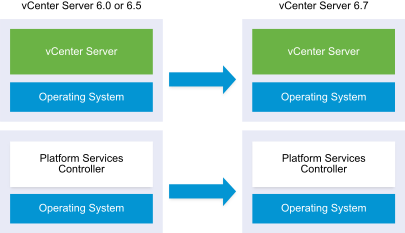To start the migration process, you use the GUI installer to deploy the OVA file that is included in the installer ISO file as a Platform Services Controller appliance.

Prerequisites
Procedure
- In the vCenter Server Appliance installer, navigate to the vcsa-ui-installer directory, go to the subdirectory for your operating system, and run the installer executable file.
- For Windows OS, go to the win32 subdirectory, and run the installer.exe file.
- For Linux OS, go to the lin64 subdirectory, and run the installer file.
- For Mac OS, go to the mac subdirectory, and run the Installer.app file.
- On the Home page, click Migrate.
- Review the Introduction page to understand the migration process and click Next.
- Read and accept the license agreement, and click Next.
- Connect to the target server to which you want to migrate the source vCenter Server.
Option Steps You can connect to an ESXi host on which to deploy the target appliance. - Enter the FQDN or IP address of the ESXi host.
- Enter the HTTPS port of the ESXi host.
- Enter the user name and password of a user with administrative privileges on the ESXi host, for example, the root user.
- Click Next.
- Accept the certificate warning, if any, by clicking Yes.
You can connect to a vCenter Server instance and browse the inventory to select an ESXi host or DRS cluster on which to deploy the target appliance. - Enter the FQDN or IP address of the vCenter Server instance.
- Enter the HTTPS port of the vCenter Server instance.
- Enter the user name and password of a vCenter Single Sign-On user with administrative privileges on the vCenter Server instance, for example, the administrator@your_domain_name user.
- Click Next.
- Accept the certificate warning, if any, by clicking Yes.
- Select the data center or data center folder that contains the ESXi host or DRS cluster on which you want to deploy the new appliance, and click Next
Note: You must select a data center or data center folder that contains at least one ESXi host that is not in lockdown or maintenance mode.
- Select the ESXi host or DRS cluster on which you want to deploy the new appliance, and click Next.
- (Optional) Review the warning message and try to resolve the warnings, if any, and click Yes.
- On the Set up target appliance VM page, enter a name for the new Platform Services Controller appliance, set the password for the root user, and click Next.
The password must contain at least eight characters, a number, uppercase and lowercase letters, and a special character, for example, an exclamation mark (!), hash key (#), at sign (@), or brackets (()).Important: The local operating system password is not migrated to the target appliance.
- On the Connect to source page, enter the details of thePlatform Services Controller instance and click Next.
- Enter the IP address or FQDN.
- Enter the user name and password of a user who has administrative privileges on the vCenter Server instance, for example, the administrator@your_domain_name user.
- Enter the Migration Assistant Port you received in the Migration Assistant instructions.
- (Optional) Accept the warning message, if any, by clicking Yes.
- On the Select deployment type page, select Platform Services Controller and click Next.
- From the list of available datastores, select the location where all the virtual machine configuration files and virtual disks will be stored and, optionally, enable thin provisioning by selecting Enable Thin Disk Mode. NFS datastores are thin provisioned by default.
- Configure the temporary network for communication between the Platform Services Controller appliance that you want to upgrade and the new Platform Services Controller appliance, and click Next.
Option Action Choose a network Select the network to which to connect the new appliance temporarily. The networks displayed in the drop-down menu depend on the network settings of the target server. If you are deploying the appliance directly on an ESXi host, non-ephemeral distributed virtual port groups are unsupported and are not displayed in the drop-down menu.
Important: If you want to assign a temporary IPv4 address with DHCP allocation, you must select a network that is associated with a port group which accepts MAC address changes.IP Address family Select the version for the temporary IP address of the new appliance. Can be either IPv4 or IPv6.
Network type Select the allocation method for the temporary IP address of the appliance. - Static
The wizard prompts you to enter the temporary IP address and network settings.
- DHCP
A DHCP server is used to allocate the temporary IP address. Select this option only if a DHCP server is available in your environment.
- Static
- On the Ready to complete stage 1 page, review the deployment settings for the target Platform Services Controller appliance and click Finish to start the OVA deployment process.
- Wait for the OVA deployment process to complete and click Continue to proceed with stage 2 of the migration process to transfer the data from the source Platform Services Controller and set up the services of the new appliance.
Note: If you exit the wizard by clicking Close, you must log in to the appliance management interface of the newly deployed Platform Services Controller appliance to transfer the data from the source Platform Services Controller instance and set up the services.
Results
The newly deployed Platform Services Controller appliance 6.7 is running on the target server but is not configured.